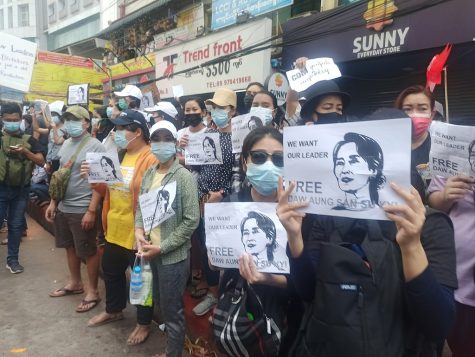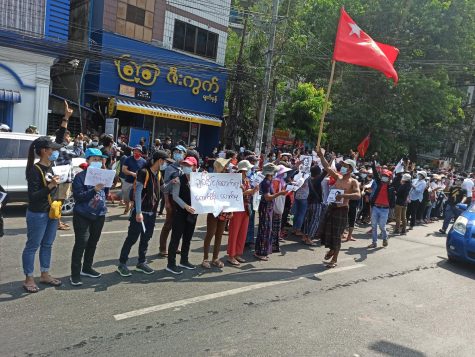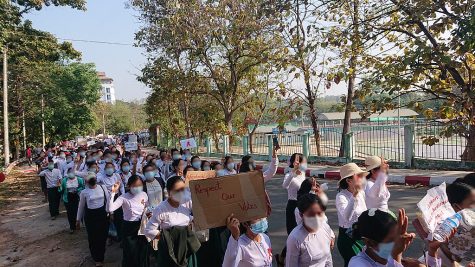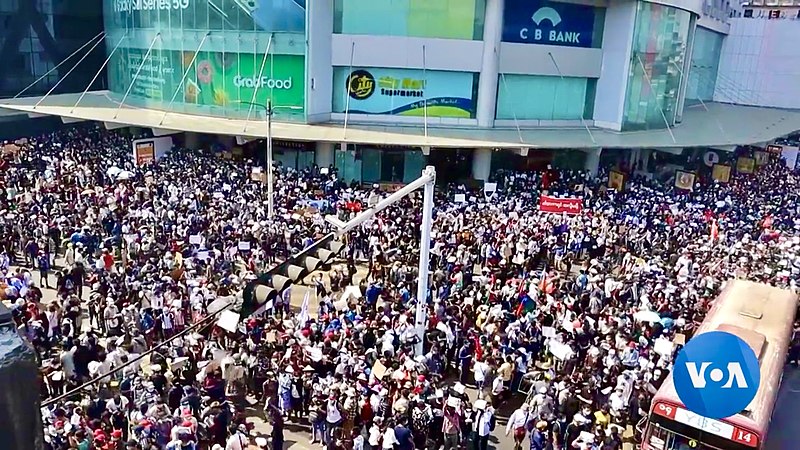Myanmar Military Coup and Protests
The situation in Myanmar has led to many anti-military protesters to be injured and killed.
In Yangon, the capital city of Myanmar, thousands of protesters gather to participate in anti-military rally.

It has been over a month since the military coup in Myanmar took over the government. Since then there has been anti-military protests across the country and many protesters have been killed.
It all started when Aung San Suu Kyi and her party, the NLD, won the general election by a land slide. The general election was held on November 1st, 2020. Then on February 1st the military took control of the government claiming that there was widespread election fraud. They also detained members of the NLD including its leader Aung San Suu Kyi. Aung San Suu Kyi is famous around the world for her work to reestablish democracy in Myanmar and has even won the Nobel Peace Prize for it. With her detainment, it has caused protests to emerge in the streets and cities of Myanmar.

Now the country is under the rule of the Army general Min Aung Hlaing. Hlaing has rose steadily in power along the military ranks and became Commander in chief in March 2011. He declared a state of emergency for one year and on his first public address since the coup, he promised to give the people a free and fair re-election. As time passes, let’s see if he keeps his promise.

I spoke with J Bawk Hkawn, who was a citizen of Myanmar prior to moving to the U.S. I asked her what she thought about the protests in Myanmar. “The people of Myanmar are protesting for freedom and for a democratic government. They are also protesting for the release of the democratic leaders that are being detained. It’s been over a month. February 1st was when the coup started. Protests have been consistently occurring ever since that day. The military is shooting the protesters and using tear gas. It’s a very bad situation going on there,” she stated. When asked about other countries involvement in Myanmar, she said, “The Myanmar people have been asking for help from the US and the UN. And there has been discussion about this in the UN.” I asked Hkawn about her family’s safety in Myanmar and she shared that “they are not 100% safe. They can’t go outside because of military orders. There is a curfew order from 8 pm to 4 am. You can only go out in the daytime. But if there are protests occurring in the area they arrest them and they shoot them. That’s why my mother and grandmother stay inside because of it. It’s not safe right now. For everyone, it is not safe.”
I also interviewed 21-year-old Brang San, who was also a citizen of Myanmar before moving to the U.S. We spoke about what he thought of the events going on in Myanmar. “It’s terrible what’s going on there,” he said. “The people of Myanmar have voiced their opinion in the recent election but it got taken away from them with this coup. The military has shut down their social media and the internet multiple times but this situation should be heard everywhere.”

Here is a timeline of events since the military coup from https://www.aljazeera.com/news/2021/2/23/timeline-of-events-in-myanmar-since-february-1-coup.
Feb 1st: Elected leader Aung San Suu Kyi, President Win Myint, and other members of the NLD were detained in a morning raid.
Feb 3rd: Medical and Hospital workers stop their work in order to join in on the anti-military protests. Charges were filed against Aung San Suu Kyi and President Win Myint from Military police.
Feb 5th: Some government workers and teachers join the Civil Disobedience Movement (CDM). They state that they won’t return to work unless Myanmar’s democratic government is restored.
Feb 6th: Social media blockages are ordered and the internet shut down. Thousands of people gather in Myanmar’s capital Yangon and other cities to join in on the protests against the coup.
Feb 7th: Internet is restored but social media is blocked.
Feb 8th: Military orders a curfew in major cities like Yangon and bans large gatherings to try to stop the protests. Min Aung Hlaing, a powerful military chief, addresses the country and promises to administer new elections.
Feb 14th: The Civil Disobedience Movement (CBD) grows.
Feb 22nd: Businesses close as thousands of protesters gather in the streets of Myanmar.
Feb 27th: The police crackdown on the protesters and arrests hundreds of them. They also open fire and shoot the crowds of protesters, injuring many.
Feb 28th: At least 18 protesters are killed.
March 2nd: Neighboring countries including Indonesia and Malaysia calls for the release of Aung San Su Kyi.
March 3rd: 38 people are killed during the protest crackdown.
Now at least two officials from Aung San Suu Kyi’s party have died in military custody. Many are worried about the health and safety of Aung San Suu Kyi, the leader of the National League for Democracy, as more violence and turmoil loom over Myanmar.




